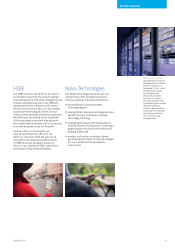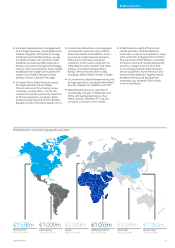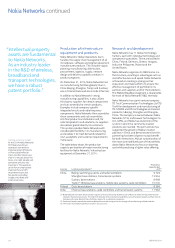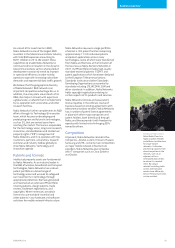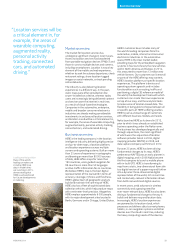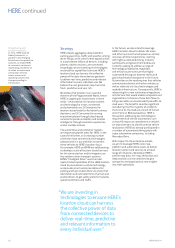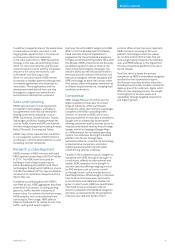Nokia 2014 Annual Report Download - page 24
Download and view the complete annual report
Please find page 24 of the 2014 Nokia annual report below. You can navigate through the pages in the report by either clicking on the pages listed below, or by using the keyword search tool below to find specific information within the annual report.22 NOKIA IN 2014
Nokia Networks continued
3. Partnering
Nokia Networks will continue to focus on
increasing its partnering activities, and in
2014 founded a new partnering unit, part
of Mobile Broadband, devoted to that goal.
We believe that this will enable Nokia Networks
to extend its addressable market beyond its
own portfolio through the market-leading
products and services of our partners such as
IP routers, data center equipment, software
stacks and systems integration solutions.
Nokia Networks also aims to enable the
plug-in of third-party hardware and software
elements, opening up previously closed
programming interfaces totrusted partners
and adjusting its own portfolio accordingly,
which we believe will help Nokia Networks
reach new customers and address
newmarkets.
4. Automation
Nokia Networks aims to use automation
to further improve its eciency, using
its analytics capabilities to enable fully
automated service deployment, maintenance
and network optimization. It also aims to use
automation in an eort to drive operational
eciencies, covering all its businesses, R&D,
nancial systems and business forecasting.
Organization
Nokia Networks has two segments:
Mobile Broadband and Global Services.
The Mobile Broadband segment
Mobile Broadband provides its customers
with exible network solutions for mobile
voice and data services through its Radio
and Core clusters. The Radio cluster covers
all technology generations—GSM, CDMA,
WCDMA, and LTE—and is investing in research
in LTE-Advanced and 5G.
The Core cluster has a comprehensive mobile
switching portfolio as well as voice and packet
core solutions. The Core portfolio is based on
Nokia Networks’ cloud-ready software and can
scale for the challenges of data growth and
Internet of Things. This provides customers
with a high level of capacity, agility and
performance to meet the increasing demands
that subscribers are placing on networks.
The Core cluster has expertise in Customer
Experience Management, virtualization and
software-rich solutions. These help Nokia
Networks support its customers in dealing
with changing technology trends. Forexample,
security is currently a pressing topic for
operators and Nokia Networks recently
opened its mobile broadband security center
in Berlin, Germany. The center is a hub of
leading expertise focused on ensuring robust
telco security and bringing together network
operators, partners, governments and
academic institutions to develop and share
network security expertise.
Other major trends addressed by the
Mobile Broadband segment include cloud
computing, analytics, big data and multimedia
content. The new partnering unit, which is
part of Mobile Broadband, exists to help
Nokia Networks achieve its goals through
partnering with recognized market leaders—
the best of the up-and-coming technology
innovators and companies that have
established reputations as leaders in their
elds. Through these activities, we believe
that Nokia Networks will be able to continue
toextend its oerings to its customers.
The Global Services segment
Through its Global Services segment, Nokia
Networks aims to provide mobile operators
with the solutions they need to create and
maintain eective networks.
Global Services comprises ve business lines.
The Network Implementation business line
provides customers with the services they
need to build, expand or modernize a
communications network. The Care business
line undertakes software and hardware
maintenance and provides training to help
our customers maximize their networks.
Within the Managed Services business line,
Nokia Networks oers services such as
network operations and service operations,
which help its customers manage service
lifecycles eciently and enhance their
subscribers’ experience (for example, by using
analytics to improve their predictive services).
Within the Network Planning and Optimization
business line, we oer solutions to improve
the performance, consistency and reliability
of our customers’ networks and services.
Finally, Global Services’ Systems Integration
capabilities ensure that all the elements
of a mobile broadband solution, including
new and mature technologies, are brought
together seamlessly.
Within Global Services, Nokia Networks has
two Global Delivery Centers, complemented
by ve Global Service Delivery hubs, bringing
together global and local services experts
as well as centralized tools and architecture.
These facilities, which deliver a growing
proportion of its services, provide eciency
for customers while at the same time
allowing operators to benet from access
to world-class skills, available as part of
NokiaNetworks’ global presence.
Sales and marketing
Nokia Networks’ sales and business teams
are active in approximately 110 countries.
They ensure that Nokia Networks is close
to its customers, both physically and in
terms of understanding the local markets,
and help it to build and maintain its
customer relationships.
In 2014, Nokia Networks grouped its customer
operations into three geographical markets:
Asia, Middle East and Africa; Europe and Latin
America; and North America. These were
further divided into regions containing sales,
business and delivery teams. On April 1, 2015,
Nokia Networks aims to implement a new
structure in its sales teams, bringing the
three markets together into one global
sales organization with the seven markets
presented below. This new structure is
targeted at allowing Nokia Networks to gain
additional speed and simplicity in dealing
with customer requirements while preserving
existing customer relationships.
■ Asia-Pacific Japan spans a varied
geographical scope, ranging from advanced
telecommunications markets—such as
Japan and the Republic of Korea—to
developing markets including Bangladesh,
Myanmar and Vietnam. Nokia Networks
works with leading operators in the market,
including KDDI, KT, NTT DoCoMo, SKT,
SoftBank and Telkomsel.



